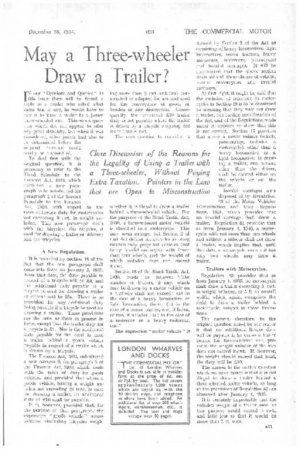May a Three-wheeler Draw a Trailer?
Page 41

If you've noticed an error in this article please click here to report it so we can fix it.
IN our " Opinions and Queries" in this issue there will be found a reply to a reader who asked what extra tax, if any, he would have to pay if he fixed a trailer to a James three-wheeled van. This was a question which did not appear to offer any great difficulty, but when it was considered, other points had alm to be determined before the original question could finally be disposed of.
To deal first with original question, it necessary to refer to Third Schedule to Finance Act, 1934, which contained a new paragraph to be substituted for paragraph 1 of the Second Schedule to the Finance Act, 1920,• with regard to the rates of licence duty for motorcycles not exceeding 8 cwt. in weight Unladen. This new paragraph deals with (a) bicycles; (b) bicycles, if used for drawing a trailer or sidecar ; and (c) tricycles.
the is the the
A New Regulation.
It is proviCled by Section 18 of the Act that the new paragraph shall come into force on January 1, 1935. After that date, the duty payable in respect of a tricycle will be £4, and the additional duty payable if a bicycle be used for drawing a trailer or sidecar will be 15s. There is no provision for any additional duty being payable if a tricycle be used for drawing a trailer. These provisions are the same as those at present in force, except that the trailer duty for a bicycle is £1. Nor is the additional duty payable for the right to haul a trailer behind a goods vehicle payable in respect of a trailer which is drawn by a tricycle.
The Finance Act, 1933, substituted a new paragraph for paragraph 5 of the Finance Act, 1920, which deals with the rates of duty for goods vehicles, and provided that where a goods vehicle, having a weight unladen not exceeding 2i tons, is used for drawing a trailer, an additional duty of £10 shall be payable.
It is, however, provided that, for the purpose of that paragraph, the expression "goods vehicle" means vehicles (including tricycles weigh
ing more than 8 cwt. unladen) constructed or adapted for use and used for the conveyance of goods or burden of any description. Consequently, the additional £10 trailer duty is not payable where the trailer is drawn by a tricycle weighing not more than 8 cwt.
The next question to consider • is whether it is illegal to draw a trailer behind a three-wheeled vehicle. For the purposes of the Road Traffic Act, 1930, a three-wheeled motor vehicle is classified as a motorcycle. This may seem strange, but Section 2 of that Act defines motorcycles as being mechanically propelled vehicles (not being invalid carriages) with fewer than four wheels, and the weight of which unladen does not exceed 8 cwt.
Section 18 of the Road Traffic Act, 1930, reads as follows :—" The number of trailers, if any, which may be drawn by a motor vehicle on a highway shall not• exceed : (a) in the case of a heavy locomotive or light locomotive, three ; (b) in the case of a motor tractor, one, if laden, or two, if unladen ; (c) in the case of a motorcar or a heavy motorcar, one."
The expression "motor vehicle" is defined by Section 2 of the Act as Consisting of heavy locomotives, light locomotives, motor tractors, heavy motorcars, motorcars, motorcycles and invalid carriages. It will be appreciated that the above section deals with all these classes of vehicle, except motorcycles and invalid carriages.
At first sight, it might be said that the omission of reference to motorcycles in Section 18 is to be construed as meaning that they may not draw a trailer, but further consideration of the Act, and of the Regulations made under it, appears to show that this is not correct. Section 17 provides that where a motor vehicle (which, presumably, includes a motorcycle), other than a heavy locomotive or a light locomotive, is drawing a trailer, one person, other than the driver, shall be carried either on the vehicle or on the trailer.
Invalid carriages are disposed of by Regulation 83 of the Motor Vehicles (Construction and Use) Regulations, 1931, which provides that no invalid carriage shall draw a trailer. Regulation 81 provides that as from January 1, 1940, a motorcycle with not more than two wheels and without a sidecar shall not draw a trailer, which implies that, until that date, a motorcycle, even if it has only two wheels, may draw a trailer.
Trailers with Motorcycles.
Regulation 82 provides that as from January 1, 1935, no motorcycle shall draw a trailer exceeding 5 cwt. in weight unladen, or 5 ft. in overall width, which, again, recognizes the right to draw a trailer behind a motorcycle, subject to those limitations.
The answer, therefore, to the original question asked by our reader is that no additional licence duty will be payable if he draws a trailer behind his three-wheeled van, provided the weight unladen of the van does not exceed Lwt. If, however, the weight should exceed that total, the duty will be £10.
The answer to the further question which we have raised is that it is not illegal to draw a trailer behind a three-wheeled motor vehicle, so long as the provisions of Regulation 82 are observed after January 1, 1935.
It is certainly improbable that the unladen weight of a trailer used for this purpose would exceed 5 cwt., and little less so that it would be more than 5 ft. wide.




















































































